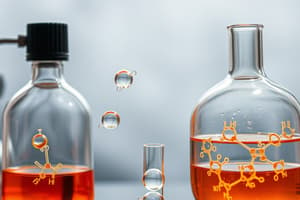Podcast
Questions and Answers
What reaction mechanism does solvolysis use?
What reaction mechanism does solvolysis use?
- E1
- E2
- SN1 (correct)
- SN2
What is the rate determining step for SN1?
What is the rate determining step for SN1?
Leaving group breaking off and leaving
What determines the rate of reaction in SN1?
What determines the rate of reaction in SN1?
Substrate concentration
When does solvolysis occur?
When does solvolysis occur?
What factors influence the rate of reaction for solvolysis?
What factors influence the rate of reaction for solvolysis?
Why do these factors influence the rate of reaction?
Why do these factors influence the rate of reaction?
What equation is utilized to determine the rate of the reaction?
What equation is utilized to determine the rate of the reaction?
How do you calculate Ea?
How do you calculate Ea?
How to calculate the rate constant?
How to calculate the rate constant?
How do you obtain y values for the graph?
How do you obtain y values for the graph?
How do you get x values for the graph?
How do you get x values for the graph?
What effect does changing solvent concentration have on the reaction rate?
What effect does changing solvent concentration have on the reaction rate?
What is activation energy measured in?
What is activation energy measured in?
What is the role of acetone in the reaction?
What is the role of acetone in the reaction?
How does the presence of water affect the reaction?
How does the presence of water affect the reaction?
What happens if the solvent is 60% acetone and 40% water?
What happens if the solvent is 60% acetone and 40% water?
Describe the room temperature procedure.
Describe the room temperature procedure.
Describe the hot and cold procedure.
Describe the hot and cold procedure.
Describe the solvent procedure.
Describe the solvent procedure.
Flashcards are hidden until you start studying
Study Notes
Solvolysis Overview
- Solvolysis is a nucleophilic substitution reaction (SN1) where the solvent acts as the nucleophile.
- The rate-determining step involves the leaving group detaching and forming a carbocation.
Rate Influencing Factors
- Reaction rate is influenced by substrate concentration, solvent type, alkyl and leaving group structure, and temperature.
- Increased substrate concentration raises reaction rate.
- Polar protic solvents enhance reaction rates due to their ability to solvated ions and stabilize carbocations.
Temperature Effects
- Higher temperatures lead to increased kinetic energy, facilitating bond breakage between central carbon and the leaving group.
- The equation for rate determination:
- logk = (-Ea / (2.30R))(1/T) + logA
- Variables: k (rate constant), T (temperature in Kelvin), A (Arrhenius constant), Ea (activation energy), R (gas constant).
Activation Energy Calculation
- Activation energy (Ea) can be derived from the slope of a graph using:
- m = -Ea / (2.30)(R)
- Requires graphing to find slope and applying the gas constant.
Determining Rate Constant
- The rate constant is calculated as:
- k = 0.104 / t, where t is time.
Graphing Values
- Y-values for graphing are obtained using:
- -log(k)
- X-values are derived from:
- Converting temperatures to Kelvin and averaging them, then taking the inverse of the average.
Solvent Concentration Impact
- Increasing water concentration accelerates the reaction due to water's effectiveness as a polar protic solvent.
- More water stabilizes the carbocation, enhancing reaction efficiency.
Role of Acetone
- Acetone aids in dissolving t-butyl chloride but does not participate directly in the reaction.
Water Stabilization
- Presence of more water solely stabilizes the carbocation, increasing reaction speed compared to lower water conditions.
Reaction Rate with Solvent Concentration
- A higher percentage of acetone (e.g., 60% acetone and 40% water) decreases reaction rate due to reduced carbocation stabilization.
Experimental Procedures
- Room Temperature Procedure:
- Utilizes a series of graduated burets and flasks; involves mixing t-butyl chloride in acetone with sodium hydroxide and observing color change.
- Hot and Cold Procedure:
- Two water baths established, one heated and one cooled; flasks equilibrated before mixing to assess temperature impact on reaction.
- Solvent Concentration Trials:
- Separate flasks for t-butyl chloride and NaOH solutions; proceeds with standard technique and repeated for accuracy.
Key Points
- Understanding solvolysis is crucial for grasping the dynamics of SN1 reactions and the impact of external factors on reaction kinetics.
Studying That Suits You
Use AI to generate personalized quizzes and flashcards to suit your learning preferences.


